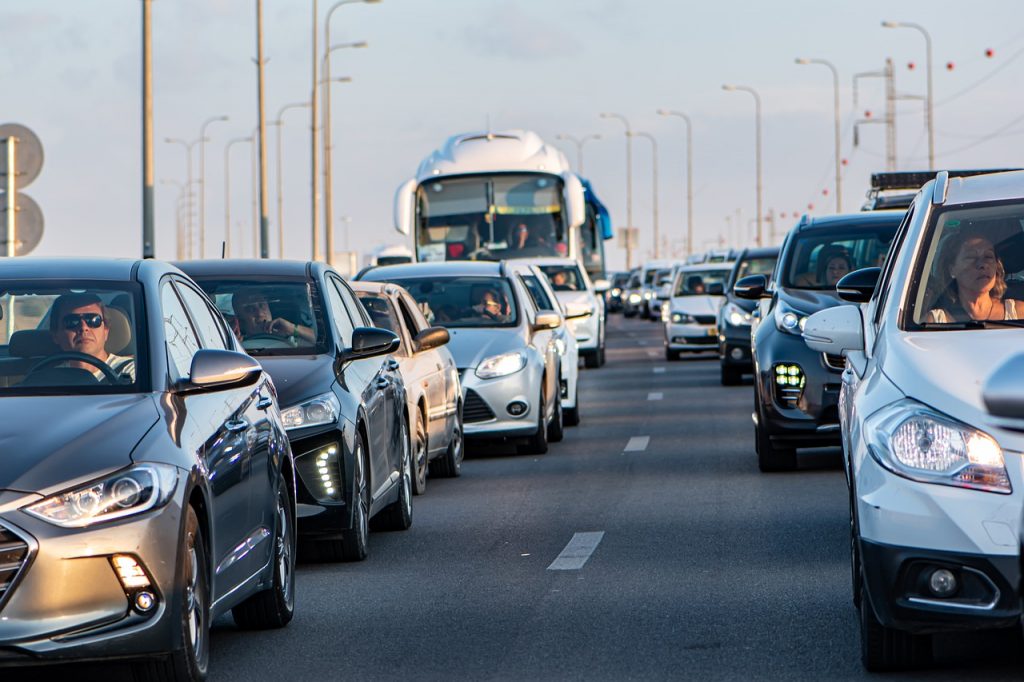
by Abby M., age 15
Plodding along in my Toyota Sequoia down I-5, with sweat causing my back to stick to the driver’s seat, I roll the car window down in order to beckon in some cool air. As I expected, I’m greeted with the smell of car exhaust erupting from a sea of cars, all of which are desperately trying to travel to places that they will never reach in time. In a valiant yet futile effort, the discordant sounds of honking cars and angry drivers urge the resolute traffic jam to pick up its pace. “As if the traffic will listen,” I think to myself. “I’ve been stuck in this vortex for almost two hours.”
In recent weeks the amount of traffic congestion in Washington State has been significantly reduced by the stay-at-home orders issued because of COVID-19. Between March 3 and March 27 of the year 2020, the city of Seattle experienced a fifty-three percent drop in travel due to the coronavirus. Shedding light on the necessity of staying at home because of the COVID-19 pandemic, the maxim “Necessity is the mother of invention” has inspired a solution to the traffic congestion epidemic. Cities such as Seattle, Washington, experience some of the worst traffic congestion in the country. Irksomely, traffic jams can cause the time it takes to drive somewhere twice as long as it would without them. If more employees began working from home, commuters wouldn’t have to battle the stress of bumper-to-bumper traffic buildups, which delay their arrival to work. In addition, companies would save money with every employee that worked from home, and the general air quality would be cleaner. Although telecommuting has been an option for employees in the last decade, it is not considered a cultural normality. If I had the means to solve the car traffic congestion situation in Washington State’s metropolitan areas, I would address it by encouraging cities and companies to increase teleworking options for their employees.
Teleworking, or working from home, would keep traffic at bay, reducing the amount of time employees spend commuting. Execrably, drivers lose valuable time because of their daily dive into the depths of a sluggish commute through traffic jams. In reference to an article published by the Seattle Times, “A Seattle-area driver who commuted at the slowest time of day would have lost 138 hours last year due to congestion, according to the 2018 annual scorecard by INRIX, the worldwide traffic-data firm based in Kirkland” (par. 1). With less people on the road, there would be a decrease in the buildup of cars. Undoubtedly, during normal circumstances traffic wouldn’t be as drastically reduced as it is during COVID-19, yet the decrease would still be significant. By working from home, employees would no longer have to combat time-consuming commutes, and the amount of traffic would shrink.
Teleworking eliminates the stress level of those otherwise forced to battle traffic on their way to work. Indeed, traffic is a cruel cause of stress for many commuters. According to an assiduous study conducted by NCBI, the National Center for Biotechnology Information, in May of 2019, “A driver’s psychological state depends on the road traffic situation, and driving stress is greater in high congestion areas than in low congestion areas. Neighbors et al. identified that slow traffic was linked to greater feelings of pressure and stress” (par. 22). Since a majority of commuters experience traffic-related stress, they arrive at work with a morning of tension already under their belts, which will likely affect their job performance. Working from home would solve the daunting struggle commuters face because of stress caused by traffic congestion. Unfortunately, tedious commutes steal valuable workers away from companies, costing them thousands of dollars. If companies were to allow employees to work from home, those companies wouldn’t lose them due to long commutes. According to MarketWatch, “more than one in five (23%) employees confessed that they have left a job because of a bad commute, according to a recent survey.” Employees who work from home don’t have to commute, so this issue is eliminated for them, and companies are more likely to keep the employees who aren’t held back by tiresome drives. AllBusiness.com, a resource for small businesses, states:
Estimates indicate that to replace an employee making $50,000 per year will cost your business 20 percent of the salary. And jobs that require high levels of training and education will have even higher turnover costs. With that in mind, companies are using remote work as a perk to retain their top talent. Ninety-five percent of employers say telework has a high impact on employee retention. This comes as no surprise as two-thirds of employees say they would take a new job in order to ease the commute. (par. 10)
With higher employee retention due to remote workers, companies could save money that would otherwise be spent on replacing employees leaving because of long commutes. When companies allow personnel to telework, they simultaneously retain employees, save money, and reduce the amount of traffic on the roads.
Another advantage to solving the traffic situation by increased telecommuting is improved air quality. Since less cars have been occupying the roads during stay-at-home orders in Washington State, the amount of atmospheric contamination has shrunk. According to an article published by the Seattle Times, “Levels of nitrous oxide (NOX), a pollutant produced by tailpipe emissions and other sources, are being detected at generally lower values in local air-monitoring devices. And a satellite that detects emissions in the atmosphere linked to cars and trucks shows declines in pollution over the Seattle area in March 2020 compared with March 2019” (par. 2). After this pandemic has passed, if more people become open to the idea of working from home, these numbers could continue to stay low. By teleworking, individuals can reduce the amount of air-defiling pollutants they emit into the air through their vehicles.
If the ability to solve the car traffic congestion situation in Washington State’s metropolitan areas were in my reach, I would address it by urging cities and companies to increase the amount of teleworking options they offer their employees. While working from home has previously been a possibility for employees, the value of it has been widely ignored. This is a mistake. The innumerable benefits of working from home include a decrease in the amount of cars on the road, a reprieve from the stress caused by traffic jams, retention of a company’s money and personnel, and an increase in air quality. Combined, these elements create a higher quality of life. Traffic grants no pleasure. Stress is draining. Time is irreplaceable. Therefore, the fewer people who allow their lives to be sucked into the traffic vortex, the better all of human life will be.
Works Cited
Digneo, Greg. “7 Benefits to Hiring Remote Workers.” AllBusiness.com. n.d. Web. 28 Apr. 2020.
“Identifying Traffic Context Using Driving Stress: A Longitudinal Preliminary Case Study.” NCBI, 9 May 2019. Web. 28 Apr. 2020.
Lindblom, Mike. “Did you lose 138 hours to Seattle-area traffic last year? New report ranks 5 other cities even worse.” Seattle Times, 11 Feb. 2019. Web. 27 Apr. 2020.
Mapes, Lynda V. “Seattle-area air quality is improving as most people stay home. But will it actually help with global warming?” Seattle Times, 31 Mar. 2020. Web. 29 Apr. 2020.
Pesce, Nicole Lyn. “More than 1 in 5 workers have quit their jobs over a bad commute, but this new tool could fix that.” MarketWatch, 1 Oct. 2018. Web. 29 Apr. 2020.
Schuman, Rick. “INRIX U.S. National Traffic Volume Synopsis: Issue #2 (March 21-27, 2020).” INRIX, 30 Mar. 2020. Web. 28 Apr. 2020.





Add Comment